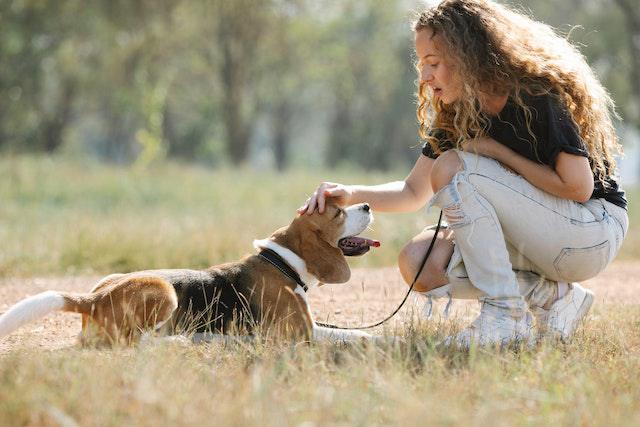15 Most Common Dog Behavior Problems With Tips

Hey there, fellow dog enthusiasts! Are you tired of dealing with your dog behavior problems?
Well, you’re in luck because, in this blog post, we’re diving deep into the world of canine behavior and exploring some common issues that might be driving you barking mad.
So grab a cup of coffee, get comfy, and let’s tackle those dog behavior problems together!
Dog Behavior Problems
The following are some common dog behavior problems:
1. Excessive Barking
Excessive barking is a common dog behavior problem that can be disruptive and frustrating for both owners and neighbors.
It can be caused by various factors, including boredom, anxiety, territoriality, or attention-seeking. Addressing excessive barking requires a multi-faceted approach.
Practical ways to address it include identifying the underlying cause of the barking, providing mental and physical stimulation through exercise and interactive toys, using positive reinforcement training techniques to teach alternative behaviors, implementing desensitization and counterconditioning to reduce triggers, and seeking professional help if needed.
2. Jumping on People
Jumping on people is a common dog behavior problem that can be both annoying and potentially dangerous. It is important to address this behavior to ensure the safety and comfort of both the dog and the people it interacts with.
One practical way to address jumping is through consistent training and reinforcement of alternative behaviors.
Teaching the dog to sit or stay when greeting people can be effective in redirecting their energy.
Additionally, providing the dog with plenty of physical and mental exercise can help reduce their excitement levels and minimize jumping tendencies.
It is crucial to reward and praise the dog for appropriate behavior and discourage jumping by ignoring or gently redirecting them when they attempt to jump. Consistency, patience, and positive reinforcement are key in addressing this behavior.
3. Chewing and Destructive Behavior
Chewing is a common destructive behavior problem seen in dogs. It often occurs due to boredom, anxiety, or teething.
To address this issue, providing appropriate chew toys and engaging in regular exercise can help redirect their chewing behavior.
Additionally, crate training can be useful to prevent access to inappropriate items. Training techniques such as positive reinforcement and redirection can also be employed to teach dogs what is acceptable to chew on.
Consistency and patience are key when addressing chewing as a dog behavior problem.
4. Digging Holes
Digging holes is a common dog behavior problem that can be frustrating for owners. It often stems from boredom, excess energy, or a natural instinct to dig.
To address this issue, providing mental and physical stimulation through regular exercise and interactive toys can help redirect their energy.
Creating a designated digging area with loose soil or sand can also give them an outlet for their digging instincts.
Using positive reinforcement training methods, such as rewarding them for not digging or teaching them alternative behaviors, can be effective in curbing this behavior.
Consulting a professional dog trainer or behaviorist may also provide additional guidance and support.
5. Nipping or Play Biting
Nipping or play biting is a common dog behavior problem, especially among puppies. It can be concerning if not addressed properly.
One practical way to address this issue is by redirecting their biting behavior onto appropriate chew toys or bones.
Consistency is key, so it’s important to consistently reinforce positive behavior and discourage nipping or biting.
Gentle, firm corrections can be used, such as saying “no” in a calm but firm tone and withdrawing attention temporarily.
Engaging in regular exercise and mental stimulation can also help reduce nipping behavior by providing an outlet for their energy.
6. Separation Anxiety
Separation anxiety is a common behavioral problem in dogs characterized by excessive distress when left alone. It can manifest in behaviors such as destructive chewing, excessive barking, and even self-harm.
To address separation anxiety, gradual desensitization and counterconditioning techniques can be employed.
This involves gradually increasing the duration of time spent away from the dog while providing positive reinforcement for calm behavior.
Additionally, creating a safe and stimulating environment with toys, puzzles, and comforting scents can help alleviate anxiety. Professional help from a certified dog behaviorist may also be beneficial in severe cases.
7. Pulling on the Leash
Pulling on the leash is a common dog behavior problem where dogs exert excessive force while walking, making the experience unpleasant for both the dog and the owner.
To address this issue, it is important to provide proper leash training and establish clear communication with the dog.
First, teach the dog basic obedience commands such as “heel” or “walk.” Use positive reinforcement techniques, rewarding the dog for walking calmly beside you. Consider using a no-pull harness or head halter to provide more control during walks.
Gradually increase the difficulty level of the walks, exposing the dog to distractions while reinforcing good leash manners. With consistency and patience, pulling on the leash can be effectively addressed.
8. Chasing Other Animals
Chasing other animals is a common dog behavior problem that can pose risks to both the dog and the animals being chased. One practical way to address this issue is through proper training and socialization.
Teaching the dog basic obedience commands like “sit” and “stay” can help redirect their focus and discourage chasing. Using positive reinforcement techniques, such as rewards and praise, can also encourage desired behavior.
Additionally, providing mental and physical stimulation through regular exercise and engaging toys can help alleviate the dog’s need to chase.
Consistency and patience are key when addressing this behavior problem, and seeking guidance from a professional dog trainer may be beneficial.
9. Food Guarding
Food guarding is a common dog behavior problem that involves aggressive or possessive behavior around food.
It can manifest as growling, snapping, or biting when someone approaches the dog while it’s eating. To address food guarding, it’s important to prioritize safety and consult with a professional dog trainer or behaviorist for guidance.
Practical ways to address it may include implementing a feeding routine to establish structure, using positive reinforcement training to teach the dog to associate people approaching their food with positive experiences, and gradually desensitizing the dog to people being near their food through controlled exposure.
It’s crucial to approach food guarding with patience, consistency, and respect for the dog’s boundaries.
10. Begging
Begging is a common dog behavior problem where dogs seek food from their owners or others during meal times.
It can be problematic as it can lead to obesity or the development of bad habits. To address begging, it is important to establish consistent rules and boundaries around feeding times.
This can include feeding the dog in a separate area or using designated feeding times.
Positive reinforcement can also be used to reward the dog for appropriate behavior during meals, such as sitting calmly or staying in a designated spot.
Redirecting the dog’s attention with toys or puzzles during meal times can also help to discourage begging behavior.
Finally, it is important for all members of the household to be consistent in their responses to begging to ensure the effectiveness of the training.
11. Stealing Things
Stealing things is considered a dog behavior problem when it becomes excessive or disruptive. It can stem from various factors such as boredom, lack of mental stimulation, or a desire for attention.
To address this behavior, it is crucial to provide adequate exercise and mental enrichment for the dog.
Training them with commands like “leave it” or “drop it” can help deter stealing. Ensuring that valuable items are stored securely and out of the dog’s reach can also prevent opportunities for stealing.
Consistency, positive reinforcement, and redirecting the dog’s attention to appropriate toys or activities can aid in curbing this behavior.
12. Not Coming When Called
Not coming when called is a common dog behavior problem that can be frustrating for owners. It can be caused by various factors such as lack of training, distractions, fear, or even health issues.
To address this problem, consistent training is key. Start by using positive reinforcement techniques, rewarding the dog for coming when called.
Gradually increase distractions and reinforce the behavior in different environments. Implementing a recall command and practicing it regularly can also help reinforce the behavior.
Seeking guidance from a professional dog trainer or behaviorist can provide additional strategies to address this issue effectively.
13. Rough play
Rough play in dogs is considered a behavior problem in most dogs when it becomes excessive or aggressive.
This behavior can lead to injuries and can be concerning, especially in multi-dog households or when interacting with humans. To address rough play, it is important to provide proper socialization and obedience training from an early age.
Engaging in regular physical exercise and mental stimulation can help channel their energy in a positive way.
Redirecting their focus with interactive toys or engaging in structured play sessions can also be effective. Consulting with a professional dog trainer or behaviorist may provide further guidance in managing rough play behavior.
14. Inappropriate Urination or Defecation
Inappropriate urination or defecation is a common dog behavior problem that can be frustrating for owners. It can be caused by various factors, including medical issues, anxiety, or lack of proper training.
To address this problem, it is important to first rule out any underlying medical conditions by consulting with a veterinarian.
Once medical causes are ruled out, a consistent routine and proper potty training can help. Providing regular bathroom breaks, using positive reinforcement for desired behavior, and cleaning up accidents with enzymatic cleaners can also be effective in addressing inappropriate elimination.
Consulting with a professional dog trainer or behaviorist may be beneficial for more severe cases.
15. Excessive Licking
Excessive licking in dogs is a behavior problem in most dogs that needs to be addressed. It can be caused by various factors, including anxiety, boredom, or medical issues.
To address this behavior, it’s important to identify the underlying cause. Providing mental and physical stimulation, such as interactive toys or puzzle feeders, can help alleviate boredom.
Implementing relaxation techniques, like massage or aromatherapy, can help reduce anxiety. If the licking persists, it’s recommended to consult with a veterinarian or a professional dog trainer for further guidance and potential medical evaluation.
Conclusion
In conclusion, understanding and addressing dog behavior problems is crucial for a harmonious relationship with our furry friends.
By taking the time to communicate, train, and provide a loving environment, we can help our dogs overcome their challenges and thrive.
Remember, with patience and consistency, we can transform these problems into opportunities for growth and deeper connection.



![Fear Aggression in Dogs [Signs, Causes & More] Fear Aggression in Dogs](https://petcreeks.com/wp-content/uploads/2023/10/barking-1819740_640.jpg)


